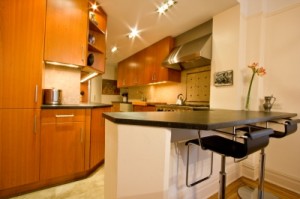 The backsplash, apart from having a practical purpose, is a vital kitchen design component because it can add a sense of completion and visual interest. Its purpose is to protect the wall behind the stove from grease spatters, smoke, stains and splashes of food during the course of cooking.
The backsplash, apart from having a practical purpose, is a vital kitchen design component because it can add a sense of completion and visual interest. Its purpose is to protect the wall behind the stove from grease spatters, smoke, stains and splashes of food during the course of cooking.
A well-designed backsplash also creates an air of sophistication and a sense of coordination with the other kitchen décor, fixtures and appliances.
Size
- A backsplash can be any size, and it doesn’t always have to be behind a stove. Sometimes they extend beyond the sides of the stove, encompassing the entire counter area – including the sinks. Some backsplashes only extend half way up a wall, while others extend right up to the cabinets, or even as high as the ceiling.
- Size depends on personal preference and budget, as well as the dimensions of the kitchen, the size of the wall and other design elements, such as cabinets.
Effects
- A backsplash can be visually dramatic. For example, you can add vibrancy and color to a monochromatic or small kitchen with a mosaic backsplash. In contrast, a backsplash made of the same materials as countertops in a large, spacious kitchen creates a different, but equally pleasing, look. Depending on the materials and colors used, backsplashes can make kitchens appear cozier, bigger or rustic.
The benefits of a tiled backsplash are threefold. It serves a purpose, it’s easy to clean, and it makes an important design statement.






